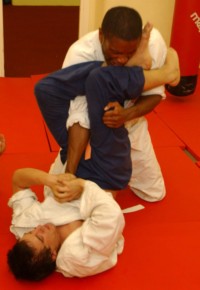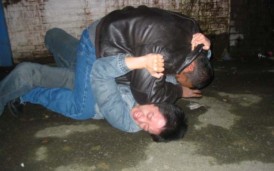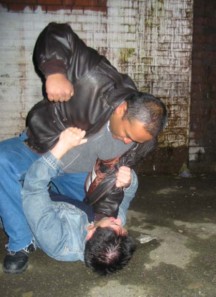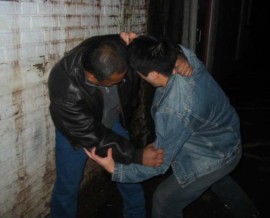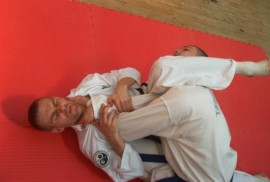How many times in recent years have you heard this comment? I must have heard
this said dozens of times in the last few years but it seems to me that no-one is really questioning where this bizarre figure comes from. I would like to start this article by stating clearly that I am a big grappling fan. I love groundfighting and believe it to be central to the Goju Ryu principles and fighting tactics that I practice. In fact I believe it to be essential to any style that makes claims on being a fighting system. Martial arts-wise I have fought semi-contact and full-contact stand-up where grappling was not allowed. I have fought in grappling bouts where strikes were not allowed, and I have fought in limited/no-rules bouts were almost anything was allowed. Outside of the dojo I have worked on the doors of pubs and clubs around the UK for something in the region of 15 years. I have taught courses to the police and the military as well as teaching door-supervisor courses to those looking to get licensed and registered to work on doors in the UK. I make these statements for two reasons. 1) To show that I am not simply part of the anti-grappling league. 2. To demonstrate that, while my experience is by no means all encompassing, I have been involved with violence and violent confrontations enough to make some reasonably sound observations on the way these things work. And the first thing that I would like to observe is that 90% of fights do not go to the ground. In fact, in my experience, nothing like 9 in 10 fights get anywhere near the ground. The cynics amongst you probably adhere to the view that the 90% thing is simply a marketing device propagated by grappling schools to attract students. While there might well be something in this, I'm not quite so cynical and believe that many people do genuinely believe that most fights end up on the floor. So let's look at some different scenarios to see where this often cited figure might have come from. In the late 1990's, the Los Angeles Police Department was charged with finding out how to better prepare law enforcement officers for violent confrontations. When their findings were published in the Los Angeles Times Magazine in 1998, they included the statement that '… a substantial number of arrests that involved force could have been prevented or handled better if the officers had been more well-trained'. The basis for this conclusion was apparently that close to two-thirds (62%) of all altercations had taken place with both parties on the ground, a contingency which the LAPD had not really been prepared for. So, it may not be 90%, but we do have a verified, legitimate study, and a verifiably legitimate figure showing 6 in 10 altercations ending up on the ground. But there's a problem. It's not a fight. Well, I suppose it is a fight of sorts, but only one party is 'fighting'. The police are charged with 'restraining' a suspect. In order to restrain an individual they are often forced to take a struggling suspect to the ground in order to subdue him. What the officers are strictly not allowed to do, is fight back in a manner which would truly represent fighting - kicks, punches, elbows, head-butts etc. Under these circumstances it's totally understandable that a high number of incidents go to the ground. In fact I'm surprised it's only 6 in 10. But even this is a far cry from saying that 90% of fights go to the ground. Okay, so that's law enforcement. But what about fights in pubs and clubs? The truth is that in 15 years of doorwork, I could probably count the number of times I've gone to ground with a customer on the fingers of one hand. In fact, I'd say that several, if not many, of the door staff that I have worked with over the years have never gone to the ground. It simply doesn't happen. Admittedly, unlike my good self, most door staff are pretty hefty, and getting them off their feet would be quite a job. Nevertheless, think back to any altercations you have witnessed involving punters and door staff and I'll bet 9 in 10 of them were not on the floor. One party may have ended up there but he's usually 'holding his teeth in with broken fingers' to use an expression of my dear old Belfast Granny. Well what about punter on punter? Ah, well now I think were getting there. This is where I've seen the fights end up on the floor on a fairly regular basis. Two untrained, unskilled, drunken fools, flailing around like windmills do indeed tend to eventually bump into eachother and fall over. However, even here according to the American Society of Law Enforcement Trainers, the figure is likely to be closer to 40% than 90%. 'In studying real life fights, we found that no more than 40% of fights ever went to the ground. When the fights did go to the ground, it was typically due to two main reasons: One; ineffective technique that led to the combatants becoming fatigued and frustrated and proceeding to a grapple, and then to falling on the ground. Two; one of the combatants tripping and falling.' So, here we have just 4 in 10 fights going to the ground, and those that did are being put down to incompetence! It's likely to be very different for a skilled stand up fighter. What about straightforward assaults? Again, while many of these do end up on the floor, the figures are generally taken from those who have not successfully managed to defend themselves. Most victims of assault are not trained martial artists. Those who manage to batter their assailants quite rightly scarper before the police arrive and arrest them! These incidents typically go unreported so the figures are skewed towards the ground. However, even here we are usually not talking about two people grappling on the floor. More often than not, we are talking about one party being kicked or beaten to the ground before being battered by one or more standing antagonists - a far cry from grappling. In my experience and research, the only area where I have managed to find any supporting evidence for the 90% claim has been in the area of male on female attack. Obviously the motives for any attack are wide and varied however, attacks on women are often sexually motivated. In these situations, going to the ground is a direct result of the nature of the type of assault and is a very common occurrence. But again, this type of attack is not what people usually mean when they talk about a 'fight'. In conclusion, I would have to simply state that 90% of fights do not go to the ground. Only a tiny proportion of the fights and altercations I have been in over the years have ever gone to the ground. I know of many who are regularly involved with security and confrontation who have never gone to the ground. In fact, I have never met anybody who is directly involved with security or conflict resolution who agrees with this 90% figure. I would hate it if anybody used this article as a reason not to study grappling and groundfighting skills. I started the article by saying how highly I personally value these skills and I'd like to reiterate that here. Grappling skills have got me out of trouble on more than one occasion - it's just rare that's all. If martial arts are to retain any level of credibility or integrity, they must be based on truth, and the truth is that 90% of fights do not go to the ground. ......................................................................................................………............……… Gavin Mulholland is Chief Instructor for Daigaku Goju Karate Kai in Central London. DGKK can be contacted, via the OMAA. |
ARTICLES The Truth about Groundfighting "90% of fights end up on the ground" by Gavin Mulholland |
